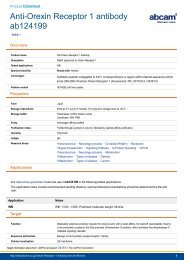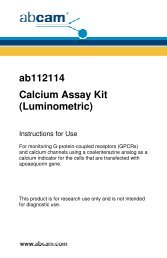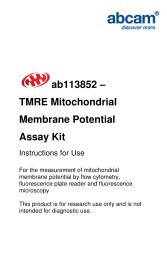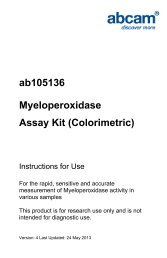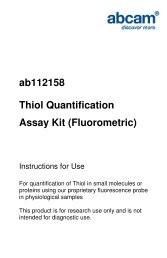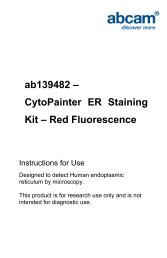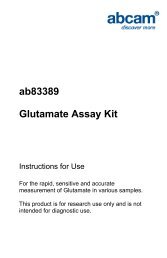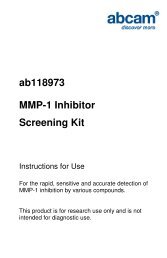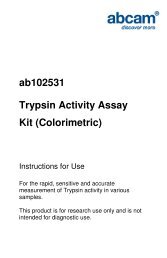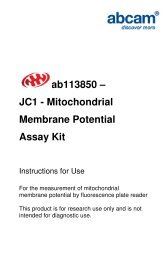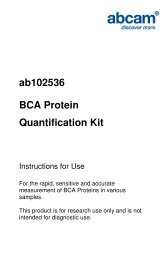ab112145 CytoPainter Mitochondrial Staining Kit - Red ... - Abcam
ab112145 CytoPainter Mitochondrial Staining Kit - Red ... - Abcam
ab112145 CytoPainter Mitochondrial Staining Kit - Red ... - Abcam
Create successful ePaper yourself
Turn your PDF publications into a flip-book with our unique Google optimized e-Paper software.
<strong>ab112145</strong><strong>CytoPainter</strong><strong>Mitochondrial</strong> <strong>Staining</strong><strong>Kit</strong> - <strong>Red</strong> FluorescenceInstructions for UseFor staining mitochondria in live cells using ourproprietary red fluorescence probeThis product is for research use only and is notintended for diagnostic use.
Table of Contents1. Introduction 32. Protocol Summary 53. <strong>Kit</strong> Contents 64. Storage and Handling 65. Assay Protocol 76. Data Analysis 92
1. IntroductionMitochondria are membrane-enclosed organelles found in mosteukaryotic cells. Mitochondria are sometimes described as “cellularpower plants” because they generate most of the cellular supply ofATP. In addition to supplying cellular energy, mitochondria areinvolved in a range of other processes, such as signaling, cellulardifferentiation, cell death, as well as the control of the cell cycle andcell growth. Mitochondria have been implicated in several humandiseases, including mitochondrial disorders and cardiac dysfunction,and may play a role in the aging process. Although most cellularDNA is contained in the cell nucleus, the mitochondrion has its ownindependent genome.<strong>Abcam</strong> fluorescence imaging kits are a set of fluorescence imagingtools for labeling sub-cellular organelles such as membranes,lysosomes, mitochondria, nuclei, etc. The selective labeling of livecell compartments provides a powerful method for studying cellularevents in a spatial and temporal context.<strong>ab112145</strong> is designed to label mitochondria in live cells with redfluorescence. The kit uses our proprietary dye that selectivelyaccumulates in mitochondria probably via the mitochondrialmembrane potential gradient. The red fluorescent mitochondrial stainused in the kit has Ex/Em = 580/600 nm. The mitochondrialindicator, a hydrophobic compound, easily permeates intact live cells3
and becomes trapped in mitochondria after it gets into cells. Thisfluorescent mitochondrial indicator is retained in mitochondria for along time since it carries a cell-retaining group. This key featuresignificantly increases the staining efficiency.<strong>ab112145</strong> can be readily adapted for many different types offluorescence platforms, such as microplate assays,immunocytochemistry and flow cytometry. It is useful for a variety ofstudies, including cell adhesion, chemotaxis, multidrug resistance,cell viability, apoptosis and cytotoxicity. The kit provides all theessential components and can be used for both proliferating andnon-proliferating cells.4
2. Protocol SummaryPrepare CellsAdd Dye Working SolutionIncubate at 37 °C for 30 minutes to 2 hoursAnalyze under fluorescence microscope atEx/Em = 585/610 nm (Texas <strong>Red</strong> filter set)5
3. <strong>Kit</strong> ContentsComponentsAmountComponent A: <strong>Red</strong> Indicator (500X DMSO Stock) 100 µLComponent B: Live Cell <strong>Staining</strong> Buffer50 mL4. Storage and HandlingKeep at -20°C. Protect from light.6
5. Assay ProtocolA. Prepare <strong>Mitochondrial</strong> <strong>Staining</strong> Solution1. Warm all the components to room temperature.2. Prepare dye working solution by diluting 20 µL of <strong>Red</strong>Indicator (Component A) into 10 mL of Live Cell <strong>Staining</strong>Buffer (Component B).Note 1: 20 µL of 500X <strong>Red</strong> Indicator (Component A) isenough for one 96-well plate. Aliquot and store unused500X <strong>Red</strong> Indicator at < -20 °C. Protect from light andavoid repeated freeze-thaw cycles.Note 2: The optimal concentration of the fluorescentmitochondrial indicator varies depending on the specificapplication. The staining conditions may be modifiedaccording to the particular cell type and the permeabilityof the cells or tissues to the probe.B. Prepare serial dilutions of Aldehyde Standard1. For adherent cells: Grow cells either in a 96-well blackwall/clear bottom plate or on cover-slips inside a petridish filled with the appropriate culture medium. Whencells reach the desired confluence, add equal volume7
(e.g. 100 µL for a 96-well plate and 25 µL for a 384-wellplate) of the dye-working solution (from Step A2).Incubate the cells in a 37 °C, 5% CO 2 incubator for 30minutes to 2 hours. Replace the dye-loading solutionwith Hanks and 20 mM Hepes buffer (HH buffer) orbuffer of your choice (e.g. the buffer with growth mediumat 1:1 concentration). Observe the cells by using afluorescence microscope Ex/Em = 585/610 nm.Note: It is recommended to increase either the labelingconcentration or the incubation time to allow the dye toaccumulate if the cells do not appear to be sufficientlystained.2. For suspension cells: Centrifuge the cells at 1000 rpmfor 5 minutes to obtain a cell pellet and aspirate thesupernatant. Resuspend the cell pellets gently in prewarmed(37 °C) growth medium, and add equal volumeof the dye-working solution (from Step A.2). Incubate thecells in a 37 °C, 5% CO 2 incubator for 30 minutes to 2hours. Replace the dye-loading solution with Hanks and20 mM Hepes buffer (HH buffer) or buffer of your choice(e.g. the buffer with growth medium at 1:1concentration). Observe the cells using a fluorescencemicroscope fitted with a Texas <strong>Red</strong> filter set.8
Note 1: It is recommended to increase either the labelingconcentration or the incubation time to allow the dye toaccumulate if the cells do not appear to be sufficientlystained.Note 2: Suspension cells may be attached to cover-slipsand stained as adherent cells (see Step B.1).6. Data AnalysisFigure 1. Image of U2OS cells stained with <strong>ab112145</strong> in a black96-well plate.For further technical questions please do not hesitate tocontact us by email (technical@abcam.com) or phone (select“contact us” on www.abcam.com for the phone number foryour region).9
UK, EU and ROWEmail: technical@abcam.comTel: +44 (0)1223 696000www.abcam.comUS, Canada and Latin AmericaEmail: us.technical@abcam.comTel: 888-77-ABCAM (22226)www.abcam.comChina and Asia PacificEmail: hk.technical@abcam.comTel: 108008523689 ( 中 國 聯 通 )www.abcam.cnJapanEmail: technical@abcam.co.jpTel: +81-(0)3-6231-0940www.abcam.co.jpCopyright © 2012 <strong>Abcam</strong>, All Rights Reserved. The <strong>Abcam</strong> logo is a registered trademark. 11All information / detail is correct at time of going to print.



